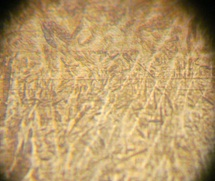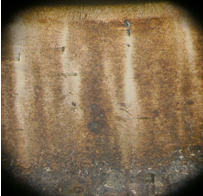Introduction
Important reserve of economy of material and labour resources is application of the superficial work-hardening the sources of heating (by a laser ray, electronic ray, plasma stream), allowing sharply to promote tenure of employment of wares, improve their operating descriptions, reduce the cost of making and repair.One of most perspective there is plasma technology, intensively developed both in our country and abroad. The use of low temperature plasma is effective not only for featherof plasma of metals and alloys, to inflict of wearproof, heatproof and коррозионностойких coverages, cutting and welding of different materials, but also for the superficial work-hardening of different wares. The conducted researches and experience of industrial application show that the plasma source of the superficial heating can be in many cases used along with such sources, as a laser and cathode-ray, providing the high indexes of process. Industrial application of the plasma superficial work-hardening requires scalene and deep consideration of technology of process and properties of the work-hardened wares. In this connection it should be noted that if technology of the laser work-hardening the large number of monographs and reference books, numerous articles and collections, is sanctified to, then technology and equipment for the plasma work-hardening, descriptions of the wares work-hardened in this way are small lighted up in literature. It is one of reasons, retentive the wide applying of technology of the plasma work-hardening in industry.
INFLUENCES OF MODES OF SUPERFICIAL PLASMA WORK-HARDENING ON STRUCTURE AND PROPERTIES BECAME 40Х
The superficial work-hardening of steel details by means of plasma arc digit is a perspective, but studied not enough method. Foremost it behaves to the questions of distribution of the temperature fields in area of, and also estimation of speeds of heating and cooling of metal heating in the process of moving of local high temperature source. Particular interest presents research of influence of the modes and speed of moving of area of heating on forming of the work-hardened layer with the purpose of receipt of optimal combination of properties and wearproofness, conditioned by structural and phase transformations what be going on in a metal.
Preliminary evaluation results, were got experimentally. As a basic parameter of process set speed of moving of area of heating and mode of burning of arc.
Researches were conducted on the setting "muktiplas 3500", moving of area of heating was carried out in the range of speeds of 1,5.4мм/c. From a nozzle to the workpart of 2-3мм. Expense of plasma mixture 0,25 liter/hour the standards of round rent Were taken by a diameter a 80 mm and long a 400 mm from steel of 40Х, maintenance chemical elements corresponded to the branded composition. Initial structure 40Х ferrit became - pearlitic. After treatment standards cut and divided.
Standards were processed in the mode of MODE 2 (burning of arc takes place between a metal and nozzle). In the process of treatment standards were consolidated with different speeds of moving of area of heating of V1=a 1,5 mm/of c, V2=a 1,8 mm/of c, V3=a 2 mm/of c, V4=a 2,6 mm/of c, V5=a 2,8 mm/of c, V6=a 3 mm/of c, V7=a 3,4 mm/of c, V8=a 4 mm/of c. It was educed at a macrostructural analysis, that at treatment of standards at a speed of V1, V2, V3, V4, V5, there is of surface, the thermal affected zone is great. The structure of such standard will have a martensite (picture 1 ). At treatments of standards at a speed of V6, V7, V8 is not observed.

Picture 1 - Microstructure of hard-tempered layer
The metallography analysis of the work-hardened standards showed with the use of optical microscopy, that the area of thermal influence of plasma stream had a form of segment (picture 2). At treatment without оплавления she consists of hard-tempered area мартенситные transformations happened in which, and frontier (transitional to the feedstock). At treatment with there is the additional superficial fluxed (tempering from the liquid state) zone

Picture 2 - Macrostructure of plasma stream on steel of 40Х
A microstructure of hard-tempered area is a very homogeneous martensite + remaining austenite + carbides. Forming of such structure is conditioned by the small sizes of austenitic grains, appearing at the high-speed plasma heating.
Conclusions
Plasma superficial treatment - simple enough and method of work-hardening of steel. Features of plasma hard-facing are the briefness of process of heating and possibility of conditioning, providing high intensity, of cooling render substantial influence on the structure of hard-tempered layer. The effect of cooling speed at metallography research is foremost noticeable in dispergating of structure. Speed of heating renders substantial influence on the size of grain, because with her number of centers of grows quicker, than speed of height of centers.
This master's work is not completed yet. Final completion: December 2013. The full text of the work and materials on the topic can be obtained from the author or his head after this date.
References
- Ставрев Д.С., Капуткина Л.М., Киров С.К., Шамонин Ю.В. Влияние плазменно – дуговой обработки на структуру превращения и поверхностное упрочнение углеродистых и легированных сталей // Металловед. и терм. обработка металлов. – 1996, N 9. – C. 16-19.
- Плазменное поверхностное упрочнение / Л.Л. Кимович, С.С. Самотугин, И.И. Пирч, В.И. Комар. – К.: Техника, 1990. – 109 с.
- Крапошин В.С., Бобров А.В., Гапоненко О.С. Поверхностаня закалка стали 9ХФ при нагребе теплом плазменной горелки // Металловед. и терм. обработка металлов. – 1989, N 11. – C. 13-17.
- Гинзбург Е.Г., Кобяков О.С., Геллер М.А., Парнас А.Л. Иследование процес сов микроплазменной закалки // Металловед. и терм. обработка металлов. – 1988, N 5. – C. 10-14.
- Домбровский Ю.М., Бровер А.В. Обработка стали воздушно – плазменной дугой со сканированием // Металловед. и терм. обработка металлов. – 1999, N 1. – C. 10-12.
- Попилов Л.Я Электрический метод обработки метал лов. – М.: Ме-таллургия 1994. – 360 с.
- Влияяние поверхностного упрочнения плазменной струей на характер разрушения углеродистых сталей / Л.К. Лещинский, С.С. Самотугин, И.И. Пирч и др. // Физика и химия обраб. Материалов, 1985. – N 3. – C. 100 – 106.
- Бейн. Э. Влияние легирующих элементов на свойства стали. Пер. с англ. М.: 1945. 330 с.
- Быков В.А. Пластичность и прочность конструкционной стали. –М.: Судпром-гиз, 1959.- 647 с.
